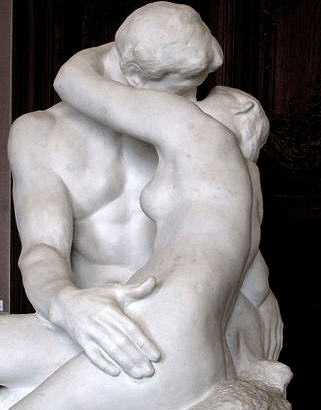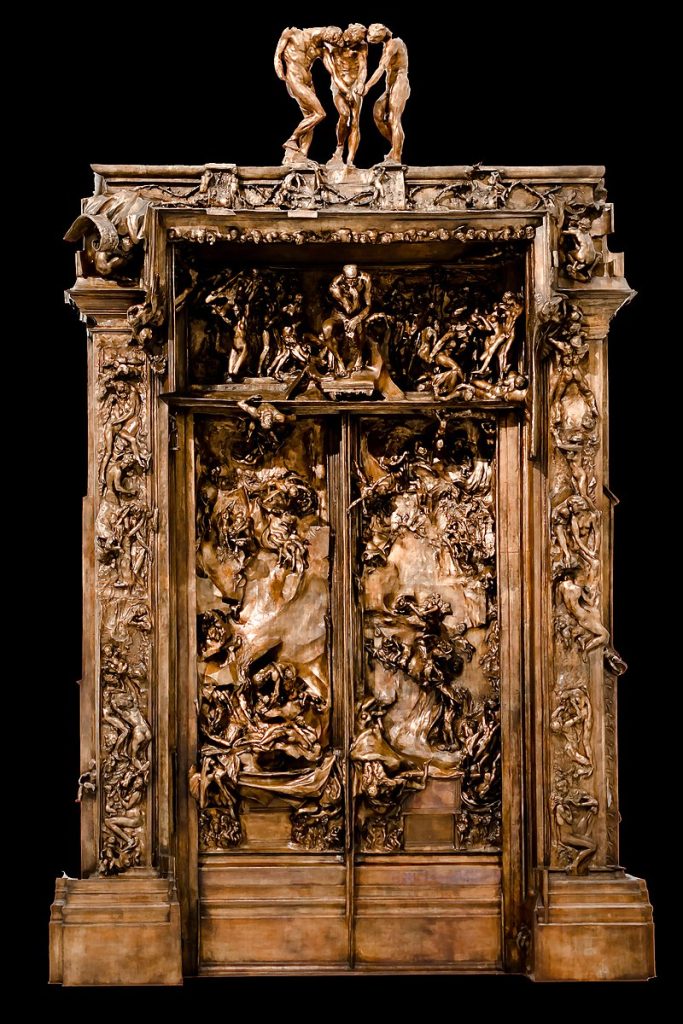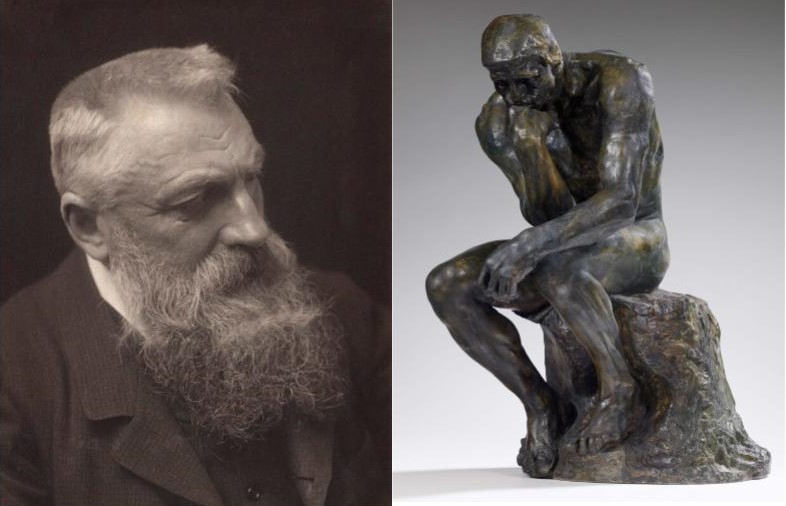French sculptor Auguste Rodin (1840–1917) is recognised as one of the most influential and avant-garde artists of the late 19th and early 20th centuries. His most celebrated works are the bronze statue “The Thinker,” which symbolises thinking, and the masterwork “The Gates of Hell,” which features several well-known characters from the Inferno, the first section of Dante’s Divine Comedy, and “The Kiss.”
Rodin was born on November 12, 1840, in Paris, France. He studied at the École des Arts Décoratifs in Paris for his initial training as a decorative artist. But he was twisted down by the official art schools of the day, such as the École des Beaux-Arts, which made him decide to go alone.
Rodin’s style broke the dominant academic traditions of sculpture in the 19th century. He was renowned for emphasising the liveliness of the human form and divulging the depth of feeling and psychology in his subjects. He continually used rough, fractured surfaces in his sculptures to suggest movement and spontaneity. Once intended to be a component of “The Gates of Hell,” “The Thinker” became one of Rodin’s most well-known pieces. The image shows a man who is sat and lost in meditation. A beautiful and sensual portrayal of a couple in an embrace can be seen in another well-known piece of art, “The Kiss.”

During his career, Rodin received acclaim and criticism for his avant-garde approach to sculpture. His creations had a profound effect on the evolution of contemporary sculpture, inspiring the likes of Constantin Brâncuși and Henri Matisse. Rodin kept up his artistic output until his passing in Meudon, France, on November 17, 1917. Today, his sculptures are displayed in museums and collections worldwide, and he is remembered as a pivotal figure in the evolution of modern art.
Aside from the criticism directed at him, Rodin is renowned for his unwavering energy and individualism in the form and content of his sculptures. Until the very end, he represents the beauty of human existence in its ugliness and quietness. Art is not an artist’s creation; it is a manifestation and invention of human life, made possible by several “thinkers” such as Rodin.
Auguste Rodin Sculpture
Auguste Rodin produced a vast body of work with many topics and themes. Rodin’s most well-known sculpture, The Thinker (Le Penseur), shows a man sitting on a rock and lost in deep meditation. It was initially conceived as part of a more significant work, “The Gates of Hell.” What made a thinker at the beginning of the 20th century, Rodin praised the ‘thinkers’ that created the new world possible. The Kiss brings the sensual and romantic aura into stillness, the sculpture depicting a couple in an embrace. It captures the intensity of a kiss between lovers.
The Gates of Hell is a monumental work of Rodin depicting Dante Alighieri’s “Inferno”, commissioned as an ornamental feature for a decorative arts museum in Paris. This project served as the inspiration for “The Thinker” and “The Kiss.” Rodin’s “Balzac” sculptures are controversial due to their departure from traditional portraiture. The Burghers of Calais, The Age of Bronze, Eternal Springtime, The Hand of God, Monument to Victor Hugo, Iris, and Messenger of the Gods are the other significant works of Rodin.
The expressiveness, focus on human emotion, and break from the traditional traditions of sculpting are characteristics of Rodin’s work. His inventive methods and commitment to encapsulating the human form’s life influenced contemporary sculpture’s evolution. Many of his sculptures are on display in museums and galleries worldwide, and his legacy continues to influence contemporary artists.
Auguste Rodin’s The Kiss
The sculpture “The Kiss” is among Auguste Rodin’s best-known works (“Le Baiser”). This sensual and passionate picture, which depicts a couple giving each other a tight hug, was done between 1889 and 1898. The sculpture captures the passion and warmth of a passionate kiss between two people. This sculpture’s composition shows a man and a woman profoundly kissing; their proximity and the way their bodies are shaped together give the image a sense of harmony and oneness.

The merged faces of the figures suggest a strong bond between the two persons, and the sculpture represents the sense that artists portray by their intimacy. By focusing on the physical characteristics of the figures, Rodin highlights their strength and muscularity in their embrace. The sculpture gains depth and authenticity from the sculptor’s use of texture and form. “The Kiss” is praised for its sensuality and ability to convey the beauty of human flesh. Rodin’s treatment of the subject matter was considered provocative and daring in its time.
The sculpture embodies the feeling that artists portray via their closeness, and the entwined faces of the figures allude to a deep bond between the two people. Rodin emphasises the musculature and strength of the embrace by paying close attention to the features of the figures’ bodies. The sculpture gains depth and authenticity from the sculptor’s use of texture and form. “The Kiss” is praised for its sensuality and ability to convey the beauty of human flesh. In its day, Rodin’s handling of the material was regarded as audacious and controversial.
“The Kiss” was first a component of a more significant project called “The Gates of Hell” (French: “La Porte de l’Enfer”), which was commissioned to be a decorative element for a Parisian museum dedicated to decorative arts. Later, Rodin made the separate sculpture “The Kiss,” which he modelled on one of the couples in “The Gates of Hell.”
The sculpture is praised for its emotional depth and creative originality, and it has come to represent romantic love for ages. There are countless casts and renditions of “The Kiss”; many of them are on exhibit in international collections and museums. The work is still a classic example of Rodin’s ability to depict his artwork’s complexity of interpersonal connections.
Auguste Rodin’s The Thinker
One of the most recognisable and famous sculptures by Auguste Rodin is “The Thinker” (French: “Le Penseur”). Initially, it was meant to be a component of a more significant commission called “The Gates of Hell” (French: “La Porte de l’Enfer”), which was created as a decorative element for a brand-new museum dedicated to decorative arts in Paris.
The sculpture depicts a naked man sitting on a rock, lost in contemplation. With his chin resting on his hand and his elbow resting on his knee, the figure is slumped forward in a position that conveys deep meditation. Many people associate philosophy, thought, and the contemplative process with Rodin’s “The Thinker.” Deep attention is represented by the figure’s intense look and wrinkled forehead. The body of “The Thinker” reflects a combination of classical ideals and a more modern, expressive style. “The Thinker,” first intended to depict the Italian poet Dante Alighieri reflecting on “The Inferno,” has evolved into a global picture of the human mind and the act of thinking. The figure is frequently understood to symbolise the process of thought and creation.
One of the most well-known sculptures in the entire globe, “The Thinker”, has been interpreted and imitated in various ways. Rodin produced several versions of “The Thinker,” exhibited worldwide in public and museum settings. Due to its strong and reflective stance, the statue has become a symbol of thought, the human condition, and the pursuit of knowledge and understanding.
Auguste Rodin’s Gates of Hell
Auguste Rodin constructed a massive sculpture group known as “The Gates of Hell” (French: “La Porte de l’Enfer”), but he never finished it during his lifetime. The project was commissioned in 1881 as a decorative element for the Musée des Arts Décoratifs, a brand-new decorative arts museum in Paris. Rodin worked on “The Gates of Hell” for many years, constantly enlarging and reworking the composition, but the museum was never erected.

The sculpture is a sizable group of figures that draw inspiration from Dante Alighieri’s “Inferno,” the opening section of his epic poem “The Divine Comedy.” Numerous historical and mythological figures are featured in the work, including The Three Shades, Paolo and Francesca, and Adam and Eve.
The suffering and agony detailed in Dante’s “Inferno” are mirrored in “The Gates of Hell.” Themes of pain, passion, and the human condition are all explored. Rodin assembled a lively and expressive group of figures by incorporating a wide range of figures in various stances and emotional states. The figurines were initially intended to be a part of the broader composition rather than as stand-alone sculptures.
Rodin never had “The Gates of Hell” cast while alive. Other artists worked on the project after he passed away in 1917, overseen by the Musée Rodin. The composition’s component figures, such as “The Thinker,” “The Kiss,” and “The Three Shades,” were cast independently and turned into stand-alone pieces. Today, numerous casts and versions of the individual sculptures from “The Gates of Hell” are displayed in museums worldwide. Even though the project is unfinished, which adds to its charm, it is nonetheless recognised as an essential and influential work of sculpture history.

Krispin Joseph PX, a poet and journalist, completed an MFA in art history and visual studies at the University of Hyderabad.





